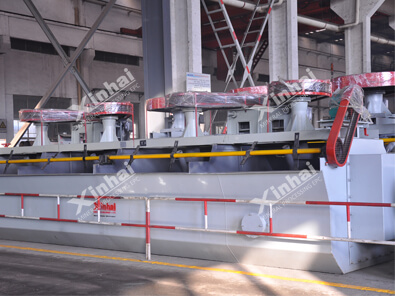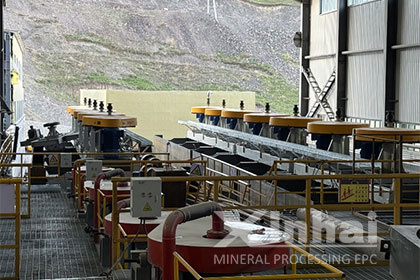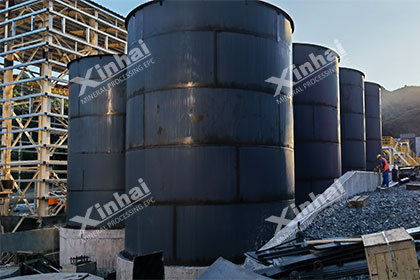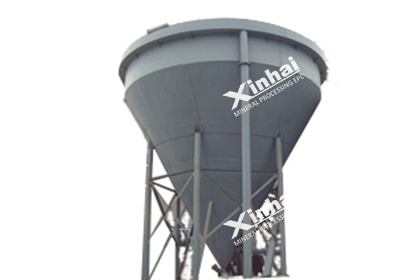How to Remove Phosphorus from Iron Ore?
 Shirley
Shirley
 Jun 18, 2021
Jun 18, 2021
 2380
2380
If you want to know more details about equipment, solutions, etc, please click the button below for free consultation, or leave your requirements!
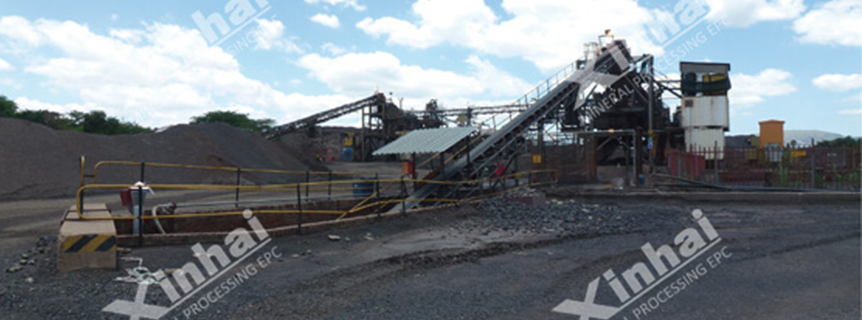
The phosphorus in high phosphate iron ore is mainly in the form of apatite or fluorapatite symbiotic with other minerals, and the embedded size of phosphorus minerals is relatively small. High phosphate iron ore is a kind of refractory ore to separate by traditional beneficiation process. What do you know about phosphorus removal from iron ore? The following article will take you to learn more about it.
The main processes for dephosphorization of high phosphate iron ore include magnetic separation, froth flotation , acid leaching, etc.
01 Iron Ore Phosphate Removal Process
Back1) Magnetic Separation Process
#1 Pros
Due to the magnetic differences between phosphorus and iron minerals in phosphate ore, conditions are provided for magnetic separation of phosphorus. Because of the economy of magnetic separation process, it has become one of the main processes of phosphate iron ore beneficiation. At the same time, the successful development of new high-gradient magnetic separator, which can greatly reduce the lower limit of effective separation size, and better solve the problem of blockage and inclusion. The drumming and pulsating structure improves the efficiency of high gradient magnetic separation significantly, and the lower limit of effective separation size can reach 10μm.
#2 Cons
For the phosphorite with very fine embedded particle size, the complex mineral symbiosis makes it difficult to achieve the purpose of effective phosphorus removal by simple magnetic separation process.
2) Froth Flotation Process
#1 Pros
Weakly magnetic iron ore beneficiation is facing a prominent problem of fine particle size, and harmful impurities such as apatite, pyrophosphate ore also embedded in a finer particle size. In order to make its monomer dissociation, often need to fine grinding. In recent years, the rapid development of selective agglomerate sorting process, provides a broad prospect for the fractionation of fine minerals. The main processes are: polymer flocculation sorting, hydrophobic agglomerate sorting, magnetic agglomerate and magnetic agglomerate sorting and compound agglomerate sorting. When the difference of single particle properties among the sorted minerals is small, agglomerates can enhance the differences between minerals, while maintaining a high selectivity.
#2 Cons
Fine grinding increases the cost of grinding, for the existence of phosphorus in the form of colloidal phosphate and embedded very fine partical size of iron ore, phosphorus minerals and iron minerals floatability is almost the same. In the process of phosphorus removal reduces the recovery of iron, it is generally difficult to obtain better sorting indicators.
3) Acid Leaching Process
#1 Pros
Acid leaching is to dephosphorize ore with hydrochloric acid, nitric acid or sulfuric acid. For ore with low grade and complex composition, it doesn’t require fine grinding to dissociate monomers. The purpose of phosphorus reduction can be achieved as long as the ore is exposed and in contact with the leaching solution.
#2 Cons
Dephosphorization in acid leaching consumes a large amount of acid, and the addition of acid leads to high leaching cost and environmental pollution. Moreover, it is easy to cause the dissolution of soluble iron in the ore, resulting in the reduction of iron recovery.
02 Factors Affecting Phosphate Removal from Iron Ore
BackIn actual production, there are many factors that affect the phosphorus removal process. Take a high phosphorus iron ore in a certain place as an example, the iron phosphorus reduction experimental study found that the leaching time, sulfuric acid dosage and agitation speed have a great influence on the beneficiation results.
1) Leaching Time
The effect of leaching time on the quality of iron ore concentrate and phosphorus removal is shown in Figure 1.
It can be seen from Figure 1: When the leaching time of sulfuric acid is 0.5~2.0 h, the grade of iron ore concentrate gradually increases and the phosphorus content decreases by prolonging the leaching time. When the leaching time is 2 h, the iron ore concentrate grade reaches a maximum of 62.32%, phosphorus content in iron ore concentrate decreased to 0.23% and iron recovery was 99.16%; as the leaching time continued, the iron concentrate grade decreases and the phosphorus content increases slightly.
This is mainly due to the fact that as the leaching time increases, the phosphorus in the crude concentrate continues to react with the sulfuric acid into solution, thus reducing the phosphorus content in iron ore concentrates. As the reaction reaches equilibrium and the leaching time continues to be extended, the phosphorus entering the solution is adsorbed on the surface the concentrate particles due to ion adsorption, the phosphorus content increased instead. Therefore, the appropriate leaching time for the test is 2 h.
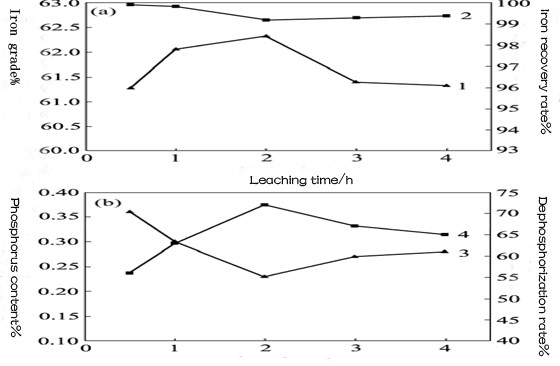
Line 1: Grade of iron ore concentrate Line 2: Iron recovery rate
Line 3: Phosphorus content in iron ore concentrate Line 4: Dephosphorization rate
Figure 1: The effect of leaching time on the quality of iron ore concentrate and phosphorus removal
2) Sulfuric Acid Dosage
Figure 2 shows the effect of sulfuric acid dosage on the quality of iron ore concentrate and the effect of phosphorus removal.
As seen in Figure 2.The increase in sulfuric acid dosage from 25 kg/t to 50 kg/t (corresponding to an increase in sulfuric acid concentration from 0.99% to 1.96%), iron ore concentrate grade increased from 60.76% Fe to 62.32% Fe, with a slight decrease in iron recovery, but still around 99%.The phosphorus content of iron ore concentrate decreased from 0.57% to 0.23%. Continued increases in sulfuric acid use to 200 kg/t reduced the phosphorus content of the iron ore concentrate to less than 0.1%.However, the excess of Sulfuric acid also caused a large loss of iron in the dephosphorization reaction, with the grade of iron ore concentrate dropping to 61.46% and the iron recovery rate only 91.13%.
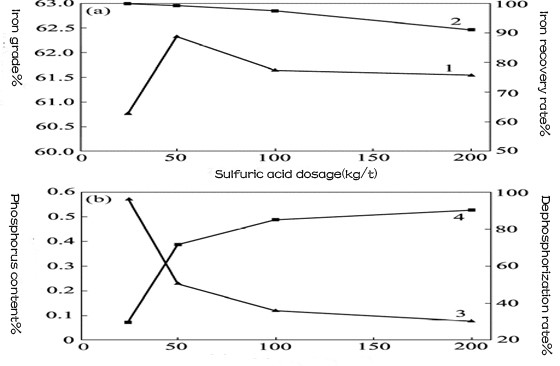
Line 1: Grade of iron ore concentrate Line 2: Iron recovery rate
Line 3: Phosphorus content in iron ore concentrate Line 4: Dephosphorization rate
Figure 2: The effect of sulfuric acid dosage on the quality of iron ore concentrate and the effect of phosphorus removal
Considering the overall production cost and iron recovery rate, the appropriate amount of sulfuric acid is 50 kg/t. In addition, since sulfuric acid cannot be completely consumed in the dephosphorus removal reaction, it can be recycled; meanwhile, some studies show that the phosphoric acid produced in the dephosphorus removal reaction can be turned into high-purity phosphoric acid, thus reducing the leaching cost.
3)Agitation Speed
Figure 3 shows the effect of agitation speed on the quality of iron ore concentrate and phosphate removal. Figure 3 shows that when the agitation speed is increased from 100 r/min to 800 r/min, the grade of iron ore concentrate is gradually reduced. The iron recovery is slightly lower, but still above 98%. However, the corresponding phosphorus content in the iron ore concentrate reaches a minimum value of 0.20% at 500 r/min and a minimum value of 0.5% at 500 r/min. The phosphorus removal rate decreases when the velocity exceeds 500 r/min.
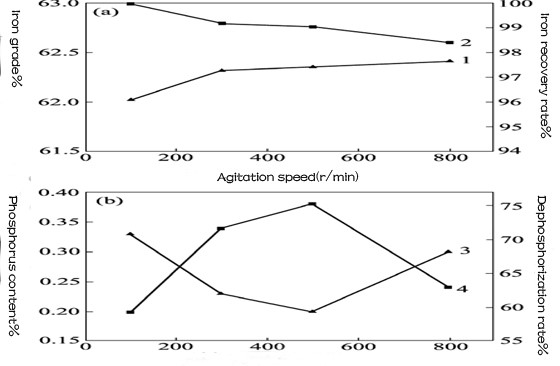
Line 1: Grade of iron ore concentrate Line 2: Iron recovery rate
Line 3: Phosphorus content in iron ore concentrate Line 4: Dephosphorization rate
Figure 3: The effect of agitation speed on the quality of iron ore concentrate and phosphate removal
This is due to the small particle size of the ore samples used for leaching, when the agitation speed is too large, the fine particles are easily driven by the whirlpool generated by the agitation. The high speed of rotation leads to a decrease in the relative agitation speed acting on the particle surface, which affects the phosphorus removal process. Therefore, a agitation speed of 500 r/min is appropriate for the test.
03 Recommendations for Iron Ore Phosphate Removal
BackAs a whole, the iron extraction and phosphorus reduction process still has the disadvantages of low phosphorus removal rate, complicated process, high iron loss rate and high cost. With the continuous development of the beneficiation process, the iron extraction and dephosphorization process have also been perfected. The future iron ore sorting process needs to pay attention to the following aspects.
Research on efficient dephosphorization flotation reagents. At present, the selectivity of collectors used to reduce phosphorus in iron ore is not very good, and the iron recovery rate is not high. Research on flotation chemicals suitable for efficient separation of iron minerals from harmful impurity minerals such as sulfur and phosphorus, as well as efficient dispersants and flotation chemicals for micro-grain iron ores should be strengthened.
Design efficient and reasonable grinding process. The phosphate minerals in iron ore embedded in the fine grain size, in the flotation process requires both useful minerals and veinstone minerals of the full monomer dissociation and not too much crushing. Research on fine grinding and classification process and equipment must be strengthened.
Improve the leaching phosphorus removal process and microbial phosphorus removal process. Shorten the process and time, reduce production cost and environmental pollution, etc.
04To Wrap Up
BackThrough the above iron ore phosphate removal content can be seen that the process has made some progress, but in the actual ore dressing process is complicated. Therefore, it is recommended that mine owners choose beneficiation process and equipment to consult with equipment manufacturers with the overall plant qualification, select the process suitable for the nature of ore, and fundamentally guarantee the production efficiency and economic efficiency of the entire plant.
 +86 183 3575 8886
+86 183 3575 8886 pinklaurabao@gmail.com
pinklaurabao@gmail.com




 Message
Message Chat Now
Chat Now


